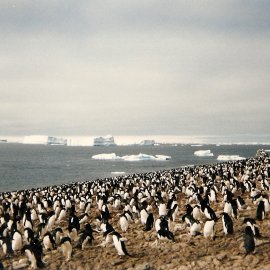It's a Great Time to Be a Citizen Scientist
-
English
-
ListenPause
[intro music] Welcome to World Ocean Radio… I’m Peter Neill, Director of the World Ocean Observatory. The phenomenon of Citizen Science has two excellent outcomes: first, it provides information that cannot be collected by the traditional methods of field research, transcending the challenges of time and cost; and, second, it enlists non-scientists – students at many levels and curious individuals – in the exploration of a challenging question, its solution, and the expansion of public awareness and action from the project derived. Add to this innovation easy access via the Internet and social media to reach other similar citizens worldwide and you have a powerful tool for study and education. This value is especially true for ocean science wherein the need for observation and data collection is distributed across a vast horizon of geographical, physical, and biological inquiry, none of which is easily or cheaply accessible. The costs to build, maintain, and operate research vessels are enormous and are mostly provided through government funding and some dedicated private philanthropy. New remote, technologically advanced observation systems are proliferating ocean wide; similar vehicles and technologies for access to the water column and sea floor are also in place. These amplify the collection of data for the most focused experiments, but are exclusive to very precise experiments and data collection and are not available to a large majority of scientists eager to investigate an almost infinite number of questions – a stunning measure of our ignorance about the ocean – how it is, how it works, and what is at risk due to change in critical environmental conditions. Let me offer some examples: Let’s say you love penguins, and want to study their behavior and count population numbers over a period of year in places you can never visit. To do so otherwise would be prohibitively time-consuming, physically demanding, and very expensive. Enter Penguin Watch ( Penguin Watch — Zoonive#261909C) established by Oxford University in England, which enlists over 4,000 volunteers to monitor aerial and time lapse images from rookeries in the southern ocean, taken by remote cameras to record size and structure of populations from year to year, and to observe molting cycles, predation, and novel behaviors otherwise unobserved. It’s penguins 24/7. Whale lover? Go to Happy Whale (https://happywhale.com/home), created by the Cascadia Research Collective, Olympia, Washington, and Allied Whale, College of the Atlantic, Bar Harbor, Maine, where you can track whales all over the world by their unique tail markings as documented by algorithm analysis of photographs taken in the most remote whale breeding habitats, migration paths, and feeding grounds. You can locate and follow, even name a particular whale from place to place, year after year. You can learn, and share, everything you want to know about whales. Head in the clouds? Go to the International Cloud Atlas (cloudatlas.wmo.int), sponsored by the World Meteorological Organization (WMO), a global reference system for observing and identifying clouds including classifications, historical information, measurements, changing characteristics and other related meteorological phenomena such as halos, snow devils and rainbows, and now publicly accessible in digital format, presenting thousands of examples of cloud formations in ten accepted categories. You can also join the Cloud Appreciation Society (https://cloudappreciationsociety.org/), created by Gavin Pretor-Pinney, where you will find cloud images and events, observation tools, information on clouds in art, music and poetry, cloud fact emailed daily, and access for upload of your personal cloud- spotting efforts. Or, if you are one of those mesmerized by phytoplankton, yes, there is a place for you too: Fjord Phyto, sponsored by the Scripps Institution of Oceanography (https://scripps.ucsd.edu/programs/fjordphyto/), where you can train to take water samples in Arctic and Antarctic fjords and submit them for comparative study of these key, ubiquitous, almost invisible exemplars of intense biodiversity. Follow turtles? Count birds? Pick your interest. For the citizen scientist, there has never been a better time nor more prolific means to be curious about our ocean world. We will discuss these issues, and more, in future editions of World Ocean Radio. [outro music]
There has never been a better time to become a citizen scientist: curious individuals interested in collecting data to build toward solutions, expanding public awareness and to help develop concrete actions for the protection of the ocean. In this episode of World Ocean Radio we list some interesting examples of ocean science initiatives for the curious at heart: from penguins to clouds, phytoplankton to whales, and many other fascinating features of the ocean world.
Do you prefer the written word? Head on over to Medium.com/@TheW2O.
About World Ocean Radio
World Ocean Radio is a weekly series of five-minute audio essays available for syndicated use at no cost by college and community radio stations worldwide. Peter Neill, Director of the World Ocean Observatory and host of World Ocean Radio, provides coverage of a broad spectrum of ocean issues from science and education to advocacy and exemplary projects.
Image
Wikimedia Commons
Resources from this Episode
- Penguin Watch
- Happy Whale
- International Cloud Atlas
- Cloud Appreciation Society
- Fjord Phyto
- Learn more about citizen science initiatives
- Login to post comments



